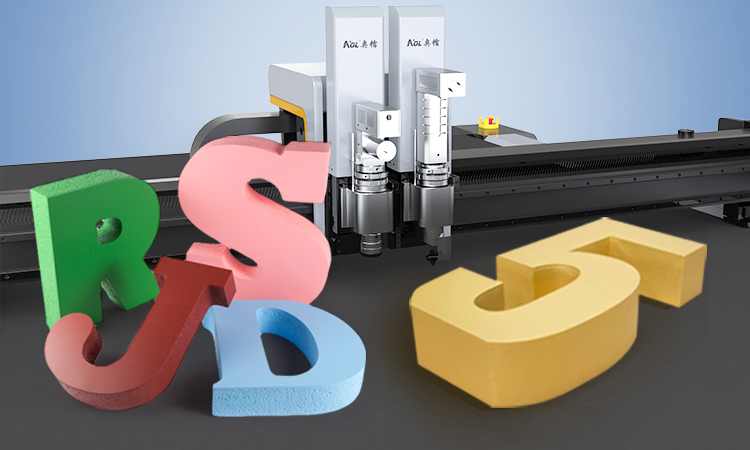Sponges and foams have a wide range of uses, including household cleaning tools, bath sponges, cleaning sponges, polishing sponges, and mop sponges. They are also used in upholstered furniture, such as sofas, office chairs, and mattresses. Furthermore, foam is widely used in the packaging industry. The sponge lining of packaging protects products from deformation and damage.

There are also many products used to cut sponges and foams, mainly manual cutting machines, punching machines, laser machines, vibrating knife cutting machines, etc.
Manual cutting machines are inexpensive, but they yield relatively low sponge utilization, are complex to operate, and require high manual skills. Furthermore, they struggle with special shapes and curves. Manual cutting is more suitable for straight lines. Furthermore, manual cutting carries a certain risk of injury. These machines are commonly used to cut thick mattress and sofa foam pads.
Punching machines are expensive, and the molds they make are also expensive. Therefore, they are ideally suited for products with a single shape that require high-volume production. For example, for products with a single shape and high production volume, such as bath sponges and cleaning pads, a square or round mold can be made to punch out multiple products at once. However, EVA foam, which has a relatively high hardness, cannot be processed with a punch press. For example, the punch cuts the edges of thicker EPE foam, which will not be perpendicular. Larger products, however, cannot be processed with a punch press; molds of this size are not practical for products over one meter long. Furthermore, operating a punch press can be dangerous, and scratches on the operator's hands are common.
With the increasing number of custom-made products on the market, laser and vibrating knife cutters, which are more affordable than punching machines, are often used for cutting, prototyping, and small-batch production of custom-shaped sponges. While laser cutting machines are inexpensive, they burn the edges, leaving light-colored sponges with a yellowish burnt edge, affecting the product's appearance. Furthermore, sponges are flammable, and laser cutting poses a significant fire risk.
The vibrating knife cutting machine is a new type of cutting equipment that has appeared in recent years. It cuts materials through the high-frequency vibration of the blade. It is a physical cutting method. Therefore, the cutting edge is smooth, without yellow edges, and there is no smoke or dust during the cutting process.
In addition, the foam CNC knife cutting machine can be equipped with a variety of cutting heads to meet various processing needs. For example, when cutting packaging lining sponge, it is equipped with a vibrating knife and a milling cutter, which can achieve cutting and grooving in one machine.
Using an oscillating knife cutter to cut EVA foam has the following advantages:
1. Precise and Clean Cutting: CNC foam cutters are designed specifically for cutting soft materials like EVA foam. They utilize a high-speed, oscillating blade that moves back and forth, achieving precise and clean cuts. This technology ensures that the cut foam remains intact without deformation or damage.
2. Versatility: Foam cutters offer greater flexibility in cutting EVA foam into various shapes and contours. The oscillating blade easily handles intricate designs, sharp corners, and complex patterns. It offers the flexibility to cut both simple and complex shapes with exceptional precision.
3. Improved Efficiency: When cutting softer materials like EVA foam, CNC foam cutters offer faster cutting speeds than CNC routers. The oscillating blade quickly cuts through the foam, significantly reducing processing time. This efficiency improvement is particularly beneficial for high-volume production or time-sensitive projects.
4. Reduced Material Waste: EVA foam cutters minimize material waste thanks to their precise cutting capabilities. By precisely following the desired cutting path, they minimize the risk of errors and ensure optimal material utilization. This reduces overall costs by minimizing material waste.
5. Ease of Use: CNC foam cutting machines are relatively easy to operate, even for beginners. They typically come with user-friendly software that allows users to easily create and modify cutting patterns. The intuitive interface and simplified programming make it easy to set up and perform cutting tasks with minimal training.
CNC cutting machines for EPE and EVA foam, with their high precision, high efficiency, and intelligent capabilities, have become the preferred solution for processing flexible materials in modern industry. They not only address the pain points of manual cutting, which struggles to meet diverse and personalized needs, but also help companies achieve cost reduction and efficiency gains, rapid delivery, and flexible production. In the future, with the deepening development of automation and intelligent manufacturing, CNC cutting technology will play a core role in even more industries.
If you need customized solutions or equipment selection suggestions for specific industries, please continue to consult.






 No.5789, Yushan Road, Jinan City, Shandong Province, China
No.5789, Yushan Road, Jinan City, Shandong Province, China +86 18560162709
+86 18560162709 250109
250109








